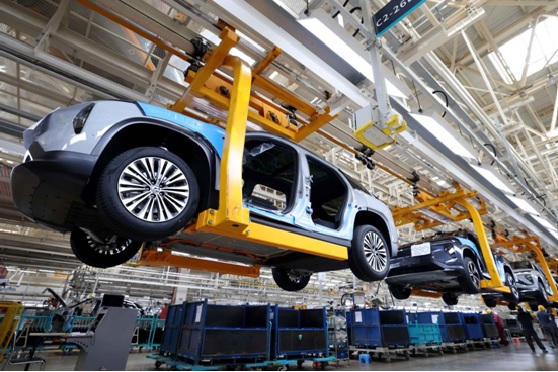By Wang Piyi
China’s new energy vehicle (NEV) industry has risen and grown strong in the past decade, becoming an important force driving the global upgrading of the automobile industry and a new signboard of China’s intelligent manufacturing.
According to statistics released by the China Association of Automobile Manufacturers (CAAM), nearly 4.57 million NEVs were sold in China in the first three quarters this year, surging 110 percent year on year and exceeding the whole-year figure in 2021.
China has ranked first in the world in terms of NEV production and sales for seven consecutive years. Last year, over half of the world’s total sales of NEVs came from China.
Xin Guobin, deputy head of the Ministry of Industry and Information Technology, said China has worked vigorously to develop the NEV industry, having issued more than 600 support policies at both central and local levels, covering technological innovation, application, safety supervision and other areas.
The country has established innovation centers for the development of power batteries and connected vehicles. The country has also supported enterprises in the industrial chain to expand R&D input and create new business models, generating strong internal impetus for NEV development.
In an attempt to make driving safer, smarter and more comfortable, Chinese carmakers have integrated new information technologies with automobile manufacturing, such as facial recognition-enabled door unlocking, driver assistant systems, and automatic warning systems, making driver-vehicle-traffic interactionpossible.
With such cross-border integration, NEVs are not merely a transportation tool but an intelligent mobile space.
Expert said that China’s NEV manufacturers’ exploration in intelligent and digital technologies has activated the industrial chain. These enterprises are blazing a trail to turn traditional manufacturing into service-oriented manufacturing, making individualized and customized products to be used in different scenarios.
Thanks to their strong capabilities in technological innovation, Chinese NEV manufacturers have witnessed rapid growth in vehicle exports and have gained better and better reputations from the global market. The CAAM recently said that 340,000 NEVs were exported in the first eight months of this year, up 97.4 percent year on year.
Chinese vehicles entered foreign markets years ago with their low prices, winning a pretty good share in Latin America and Africa. Today, China’s NEV exports are further expanding.
Chen Shihua, deputy secretary-general of the CAAM, noted that nearly 10 Chinese carmakers are selling NEVs to Europe, and Chinese electric vehicles now account for 10 percent of those sold in European countries.
According to the China Automobile Dealers Association, Europe is a major export destination of NEVs for Chinese auto manufacturers. Last year, 49 percent of China’s NEV exports went to Europe.
Apart from that, China’s electric vehicles (EV) are moving to the higher end of the overseas market. Chinese electric vehicle maker NIO recently announced plans to extend its services to Germany, the Netherlands, Denmark and Sweden. The company entered Norway a year ago, and its EV model ES8 maintained the bestselling 6-seater and 7-seater SUVs in Oslo in the first nine months of this year.
William Li, founder and chairman of NIO, told People’s Daily in an interview that China is a world-class manufacturer when it comes to “intelligent,” “electric” and “automobiles.” The country is competitive in terms of its supply chain and human resources, he added.
According to Li, NIO will hit more high-end markets in developed countries and bring more intelligent and green experiences to users.
The automobile industry faces a huge opportunity of industrial upgrading in the era of 5G. Relevant enterprises will compete in making electric, connected and intelligent vehicles. On a new “race track,” Chinese NEV manufacturers are constantly improving product performance, intelligent technologies and comprehensive services, upgrading “made in China” to “created in China” and to “intelligent manufacturing in China.”













